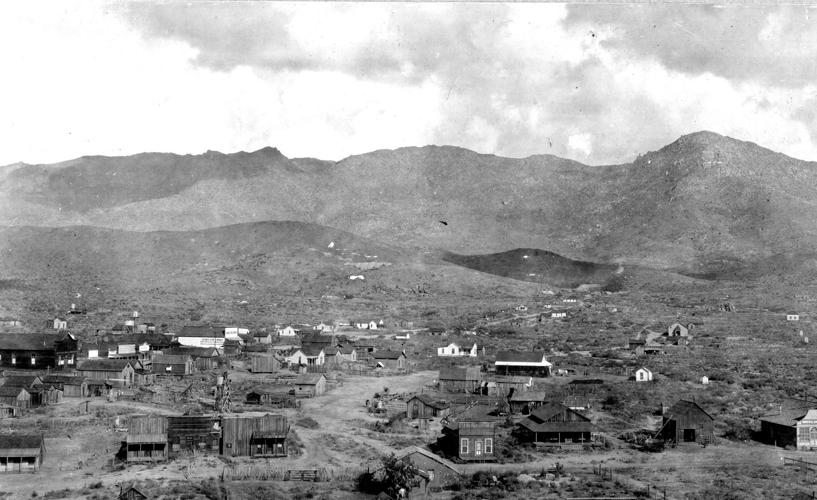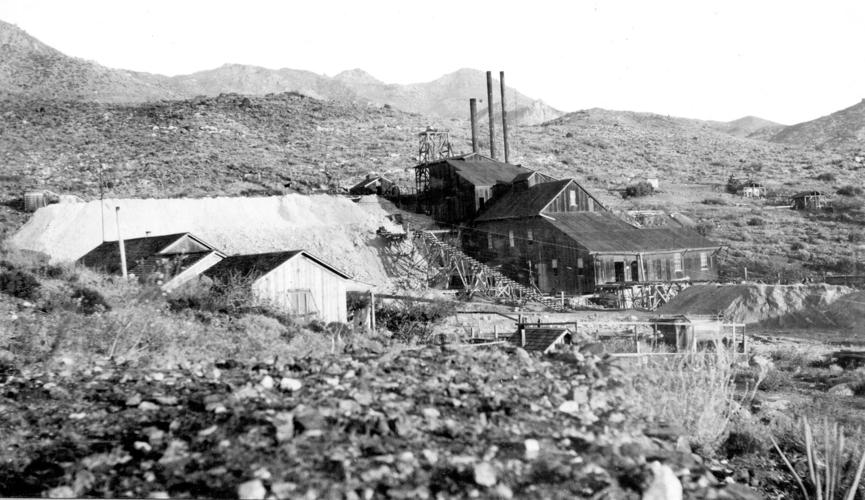The Cerbat Mountains near Kingman yielded millions of dollars worth of silver, gold, copper, lead and zinc in the mining boom years between the 1860s and World War II.
The mountains themselves are composed of granite, gneiss and pre-Cambrian schist interspersed with volcanic rock. The name Cerbat is derived from the local Hualapai or Wallapai Indian word meaning “bighorn sheep”.
The range, 15 miles northwest of Kingman in Mohave County, extends 30 miles north-northwest in length, with a maximum width of 12 miles. Its highest elevations are Mount Tipton at its northern part at 7,148 feet and Cherum Peak to the south at 6,983 feet.
The nearby town of Chloride was aptly christened on account of silver chloride ore discovered during the Silver Hill strike of the 1860s. The town was established in 1864 at an elevation of 4,009 feet; its post office opened a decade later.
It was the arrival of the railroad through Kingman in 1883 that provided an impetus to the development of mining operations in the Cerbat Mountains. Hardrock miners saw the opportunity to exploit the mineralized lode known as the Elkhart Vein, which ran through the mountain range. The ore from the Cerbat Range is classified as a complex mixture of sulfides of lead, zinc and copper along with secondary minerals of gold and silver.
By 1899, the Arizona and Utah Railroad Co. was organized with the establishment of a 25-mile rail line beginning with the Atchison, Topeka & Santa Fe Railway near Kingman on the north to its terminus around the south end of Silver Hill near Chloride. Chloride reached a population of 2,000.
One of the best-known mines was the Tennessee-Schuykill Mine, the largest producer in the Wallapai Mining district composed of Chloride, Cerbat, Mineral Park and Union Base. It operated between 1898 through 1948 and is credited with a production of $7.5 million in gold, silver, copper, lead and zinc. The early years saw the greatest production, with a 120-ton per day concentrator built and operated by the Wallapai Mining Co. The Tennessee Mine faced challenges when, on April 15, 1900, a pile of wood was set afire, adversely affecting the mill and the timber in the No. 2 shaft. Fortunately for the company, its insurance covered the cost of the mill damages.
Another excellent producer was the Elkhart Mine, although its operations were hindered due to a lack of sufficient water to run its concentrator full time. These great-producing mines were located at the base of the mountain.
Other notable mines within a several-mile proximity of Chloride included the Rainbow Mine, Pay Roll Mine and Samoa Mine. However, these mines were located higher up on the mountain, up to an elevation of 6,200 feet, with the topography forcing the Rainbow Mine to use an aerial tramway to transport ore. The Rainbow Mine, developed by H. L. McCarn, began shipment using this means of transport beginning in 1913. The Pay Roll Mine was discovered on the western slope of the Cerbat Mountains nearly 2 miles east of Chloride in 1887. Over the next 20 years, development occurred with shafts extended down to 225 feet along with a series of tunnels encompassing 600 feet. By 1929, a 50-ton flotation plant treated 1,400 tons of complex copper-lead-zinc ore onsite.
Over the next several years, mining production increased in Mohave County, as the market price of zinc averaged between 14 cents and 27 cents a pound. While 6 million pounds of lead were annually mined between 1915 and 1917, zinc production reached as high as 17 million pounds annually. The value of the mined metals in Mohave County, excluding gold production, reached $2.8 million in 1917. Lead ores were processed at the Needles and Humboldt smelters and the zinc ores were shipped out to smelters at El Paso and Bartlesville, Oklahoma.
During this boom due to the mineral market, the town of Chloride saw unprecedented growth, with two large hotels built on Tennessee Avenue including a two-story, 75-room hotel financed by Garrison and Townsend in 1916, followed by the expansion of the Ryan Hotel built by J. P. Ryan with funding from a California syndicate.
Chloride had a history of fires, the most severe occurring on May 21, 1927. The conflagration consumed half of the business district.
Mining saw a decline shortly after World War II.
With limited mining operations nearby, today Chloride serves as a historic attraction with a couple hundred residents.





